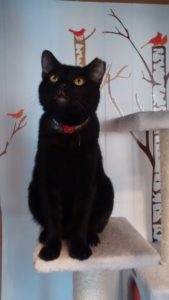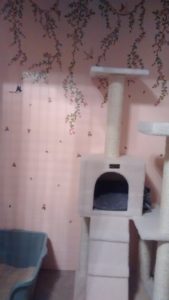People often have an aversion to seeing animals in a cage, even though that “cage” may be as large for the animal as your bedroom, office, or dining room, is to you. This leaves people in the animal rescue industry with a dilemma. All animals don’t get along any more than all people get along. Animals actually like some separation and privacy at times too. That’s especially true of certain very timid animals. Other times, separation is for quarantine purposes or due to illness. Still other times, that’s a way to gradually introduce a new animal. Yet, people look at any hint of a–oh no, here comes that word–cage–with horror.

 Rescue groups quickly learn to monitor their language carefully. We’ve learned to take as many photos as possible without showing an enclosure, no matter how essential or how nice. The real problem is that small organizations get unfairly criticized in this area. Several lovely rooms, or a large shelter building with real walls dividing many play and housing areas, is wonderful–and expensive. Less expensive enclosures are just as functional. They simply aren’t as appealing to the eye. Sometimes we have to chose whether to save more cats or build pretty buildings. Our donors profess they want the cats saved, but they may actually object to seeing plain wire framed dividers instead of walls.
Rescue groups quickly learn to monitor their language carefully. We’ve learned to take as many photos as possible without showing an enclosure, no matter how essential or how nice. The real problem is that small organizations get unfairly criticized in this area. Several lovely rooms, or a large shelter building with real walls dividing many play and housing areas, is wonderful–and expensive. Less expensive enclosures are just as functional. They simply aren’t as appealing to the eye. Sometimes we have to chose whether to save more cats or build pretty buildings. Our donors profess they want the cats saved, but they may actually object to seeing plain wire framed dividers instead of walls.
In reality, wire dividers may be best for the cats too. They are not isolated. They get air and light. They can interact to some degree, while remaining safe–and getting acquainted. In many rescue organizations, the population changes frequently. Ours does. That makes the interactions unpredictable, also making dumping all the animals into a room a poor arrangement. On the other hand, walls isolate them from other activity and other cats. Sometimes isolation is needed for quarantine or contagious illness. More often it’s not. These structures are cost effective, mobile, moveable, usable indoors and out, and easy to reconfigure. They are functional as opposed to beautiful. The cats have a blast running over the tops of the enclosures, patting at each other, through openings, and talking like neighbor kids at a backyard fence.
The rescue dilemma is that we need volunteers and donations. We also need to stretch every dollar. If we don’t appeal to our donors and volunteers, we don’t succeed and help the animals. Yet, the budget is limited. It is necessary to make practical choices based on our population (what we do and what type of animals we rescue), the demand for services, and the budget.
Reality is that cats sleep–a lot. Does it matter whether it’s in a condo or on a bed, if they are safe, clean, well-fed, and getting lots of love, playtime, and attention every day? Should we only save three cats that can have an entire room to themselves, or should we save six or eight or ten and keep them safe and secure by using condos? In our intake home, there are enclosures and condos. There are also beds and cat trees in every room, along with two exercise areas outside for dogs. Every animal gets lots of attention and freedom, just not all at one time.
In addition, our focus isn’t on permanent housing for the animals in respite care. Our job is to keep them safe and healthy until they go home to their owner. They won’t live here forever. They may not have been around other dogs or cats, and they may not be here long. In those cases, we don’t want to upset the permanent population dynamics or get the visitor more confused. We give them personal time, like they had at home, and their own room as often as possible. When we make choices as an outside observer and by visual esthetics only, often, we are not well enough informed to judge what’s best for the animal at that time and in that situation. I’ve been guilty of that too.
It’s important to know the organizations you support and take time to learn what happens behind the scenes. You are right to ask questions. Most organizations are doing the right thing for the right reasons–but not all of them. Call, visit, write, arrange a tour, and feel free to ask questions. The cover may not be gorgeous, but the story can still be beautiful.
